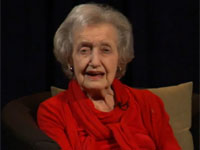The Military as Microcosm
 The United States military may be a unique institution, but it is also a microcosm of society as a whole — especially when it comes to health care. The treatment of soldiers, their families, and veterans can illustrate how large-scale organizations are able to increase the use of treatments that have been scientifically tested and validated when they provide behavioral health care. At the clinical science forum “Organizational Efforts to Disseminate and Implement Empirically Supported Interventions in Health Care Systems,” clinicians from both the Air Force and the Department of Veterans Affairs (VA) health care systems discussed training and dissemination efforts for five different treatments used for posttraumatic stress disorder (PTSD), depression, and family and couples therapy.
The United States military may be a unique institution, but it is also a microcosm of society as a whole — especially when it comes to health care. The treatment of soldiers, their families, and veterans can illustrate how large-scale organizations are able to increase the use of treatments that have been scientifically tested and validated when they provide behavioral health care. At the clinical science forum “Organizational Efforts to Disseminate and Implement Empirically Supported Interventions in Health Care Systems,” clinicians from both the Air Force and the Department of Veterans Affairs (VA) health care systems discussed training and dissemination efforts for five different treatments used for posttraumatic stress disorder (PTSD), depression, and family and couples therapy.
“PTSD is not new to military mental health,” said Kellie Crowe, from Wilford Hall Ambulatory Surgical Center at Lackland Air Force Base in San Antonio, TX. Indeed, a 2008 RAND report estimated that the societal cost of PTSD and major depression over two years is approximately $4 billion. It is not that empirically validated treatments for PTSD do not exist, she explained, “They work, but they are not used.”
The clinical leadership at Wilford Hall, which is the largest Air Force training site in the country, wanted to make sure that 100 percent of the patients seen at the PTSD clinic received empirically validated treatments. This effort involved building a sustainable and comprehensive training platform for all trainees and staff, including nine faculty psychologists, 27 psychology residents, and one psychiatrist all being trained to provide evidence-based treatments for PTSD. Because the psychology residents were then deployed to other areas in the Air Force health system, they brought their training with them. The results were impressive. In 2009, they found that only 27 percent of patients received empirically supported interventions, but by 2012, 56 percent of patients throughout the Air Force received those interventions.
One such treatment is cognitive processing therapy (CPT). Those who suffer from PTSD are often tormented by uncontrollable thoughts. They ruminate obsessively about the trauma itself, and this rumination affects their own sense of themselves in the world. Cognitive processing therapy is divided into four major stages. During the first stage, the client simply learns more about PTSD itself, what the disorder means, and what skills are necessary to get some control over feelings that often seem out of control. The second phase involves helping the client become aware of the specific repetitive thoughts and feelings that are part of their experience of PTSD. Once awareness of those thoughts and feelings occurs, the patient is taught a set of skills for coping with them. Finally, the patient learns how to replace one belief system with a healthier, more resilient one.
“We have the expectation that patients can and will recover from PTSD if they put work into it,” Ellen Healy, from the Boston Veterans Affairs Healthcare System, said during her talk on CPT.
Since 2007, the VA has embarked on a program to standardize training of CPT. That program has included 45 fully funded workshops at Veterans Centers and the Department of Defense. The 2,984 clinicians who attended the workshops in CPT agreed to complete a minimum number of cases along with attending advanced lectures and teleconferences. Not only did the clinicians feel more confident in providing treatment because their skills had been sharpened, but they also noticed that their clients responded to the treatment more positively than they did to other treatment options.
The more a person tries to avoid the awful feelings of having been traumatized — the shortness of breath, the terrible memories, the overwhelming feeling of anxiety — the more the trauma is reinforced. Prolonged exposure therapy is a treatment for PTSD that exposes the client in carefully supervised settings to the thoughts, feelings, and situations that triggered the trauma in the first place. Bradley E. Karlin, from the Office of Mental Health Services in the Central Office of the Department of Veterans Affairs, explained the treatment in his talk, entitled “Dissemination of Prolonged Exposure (PE) Therapy in the VA Health Care System: Training Model, Evaluation and Future Directions.”
Of the 1,466 clinicians trained in prolonged exposure therapy throughout the VA, 1,050 completed the training. Of them, 56 percent were psychologists, 38 percent were social workers, and 2 percent were psychiatric nurses and other specialists. They treated 3,777 veterans, and 82 percent of them saw some improvement in their PTSD symptoms over the course of treatment. The challenge facing the VA, said Karlin, is “to build a community of practice” that eventually evolves into a self-sustaining program.
But PTSD is not the only disorder that soldiers, veterans, and their families encounter. Karlin went on to discuss the challenges and opportunities of implementing cognitive behavior therapy (CBT) in the VA Health Care System. The VA trained 627 clinicians in CBT for veterans and military service members. They found that one of the strongest elements revealed in the training was the importance of the “therapeutic alliance” between the client and the therapist. After the training, clinicians reported a significant improvement in patient competencies. Additionally, 44 percent of the veterans reported that their depression was reduced and they felt as if they had more control over their lives.
Robyn Walser, from the VA in the Palo Alto Health Care System, discussed the dissemination of acceptance and commitment therapy (ACT) for depression in the VA. Although the therapy is connected to CBT, it urges people not to just control their thoughts and feelings. Rather, ACT encourages clients to accept their state of mind and feelings and to set goals according to personal values by employing mindfulness techniques. They were not simply training clinicians, Wasler explained, they were also “working on the theory underlying what we are trying to do. This was not just about learning techniques but…thinking about things functionally.”
Moving from the individual to the family, Shirley M. Glynn, from the Clinical Research Office of Mental Health Services at the Los Angeles VA, discussed integrative behavioral couples therapy as an evidence-based treatment. She explained that in the two and a half years this program has been part of the VA in Los Angeles, they “moved the whole culture of the institution around.” Whereas services were once balkanized, the strategy behind this therapeutic approach is a “graduated continuum of services” that better meet the varied needs of veterans seeking mental health services for their loved ones.
The implications for this kind of clinical research within the context of the VA are profound. In Fiscal Year 2011, the VA treated 5.4 million patients in more than 900 points of care, with 1.3 million being treated for some kind of mental health problem. As APS Fellow Antonette Zeiss, the chief consultant in the Office of Mental Health Services at the Veterans Health Administration, said: “It is quite striking to me how much of a consensus seems to be emerging when we discuss the process of effective dissemination of evidence-based therapies.”
And often what begins in the military resonates throughout society.




APS regularly opens certain online articles for discussion on our website. Effective February 2021, you must be a logged-in APS member to post comments. By posting a comment, you agree to our Community Guidelines and the display of your profile information, including your name and affiliation. Any opinions, findings, conclusions, or recommendations present in article comments are those of the writers and do not necessarily reflect the views of APS or the article’s author. For more information, please see our Community Guidelines.
Please login with your APS account to comment.